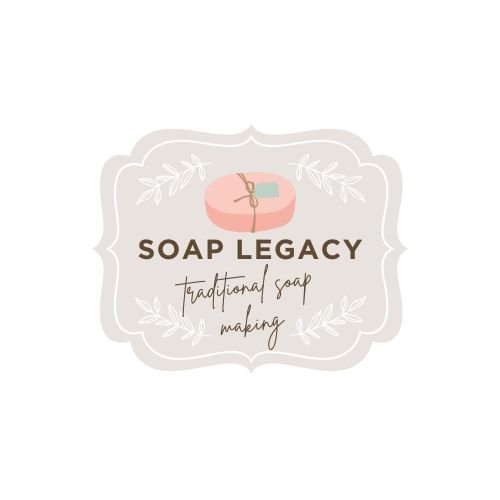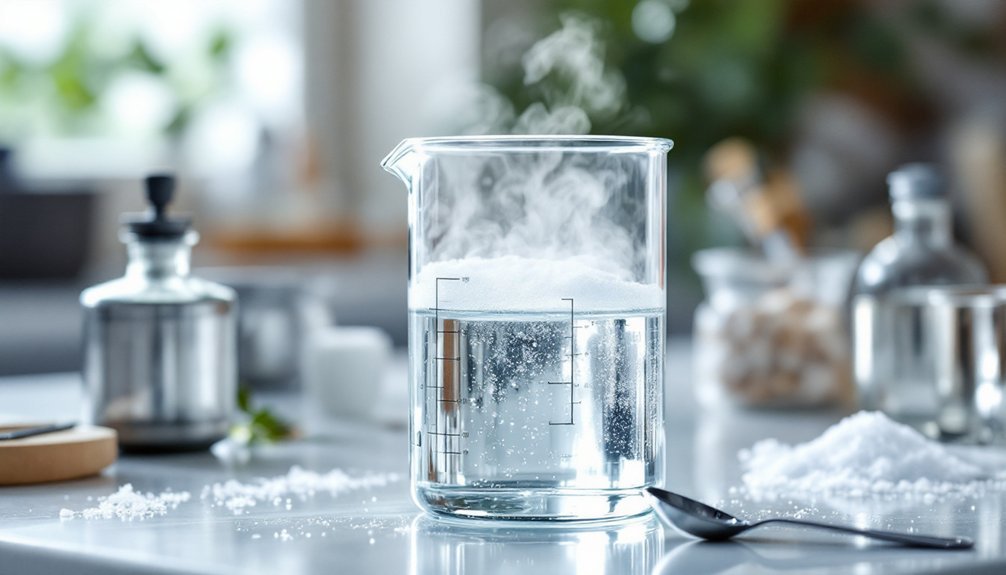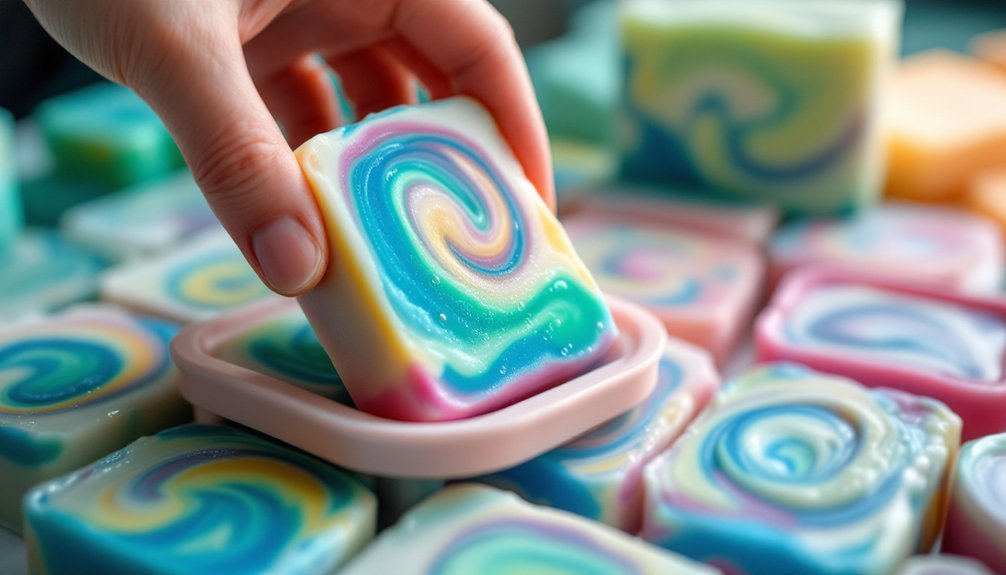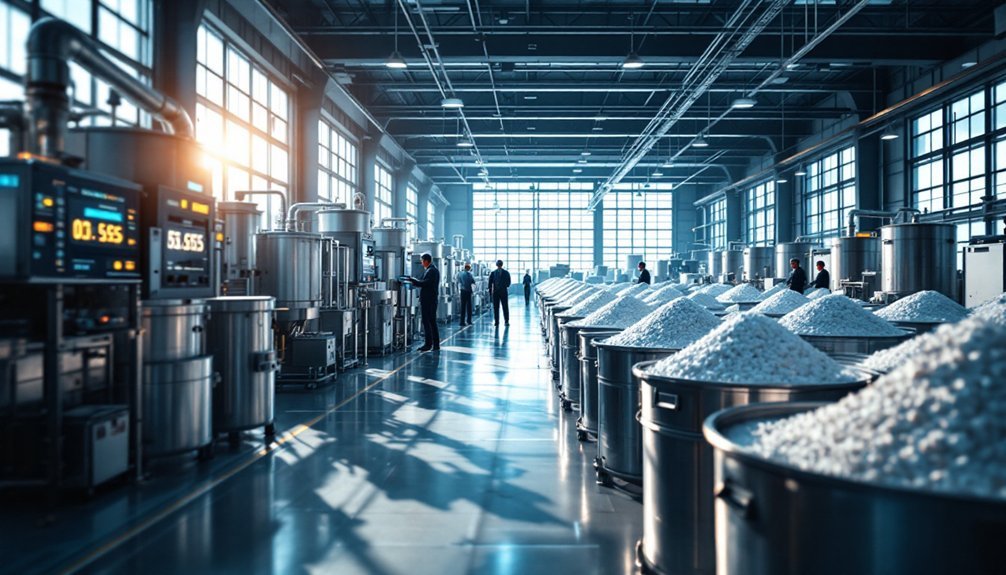For DIY soap making, choose stainless steel containers for durability and chemical resistance, or high-quality plastic marked #5 PP or #2 HDPE. Avoid glass due to thermal shock risks and low-grade plastics that warp with lye. Select containers with wide bases and tall sides to prevent splashing, and always use dedicated equipment to prevent cross-contamination. Your container choice directly impacts both safety and the quality of your finished soap creations.
Best Mixing Containers for DIY Soap Makers

Two essential qualities define the best containers for soap making: safety and durability.
When mixing lye solutions with oils, stainless steel containers stand out as the premier choice due to their non-reactive properties and ability to withstand lye's caustic nature.
If you're looking for alternatives, high-quality plastic containers marked with #5 polypropylene (PP) offer excellent chemical resistance and can handle the high temperatures generated during mixing.
Rubbermaid bowls with approximately 6.2-cup capacity work well for smaller batches, giving you adequate space for mixing and pouring.
Always select containers designated for food use to guarantee they're free from harmful chemicals.
Additionally, avoid glass containers entirely when working with lye—they can break from thermal shock, creating dangerous situations during your soap making process.
Essential Safety Considerations for Soap Making Containers

Safety measures go beyond just selecting the right container for your soap making adventures. When working with lye and water, you'll need to choose materials that resist chemical corrosion.
Always opt for stainless steel or high-quality plastic containers marked #5 PP or #2 HDPE.
Never use glass containers for mixing lye solutions—they can break from thermal shock, causing dangerous spills. Your plastic container for mixing should be heat-resistant and specifically designed for chemical use to prevent degradation and chemical leaching.
Don't forget your safety gear! Wear protective goggles and gloves whenever handling lye to avoid painful burns.
Keep your soap making equipment completely separate from kitchen utensils to prevent cross-contamination that could endanger your family's health.
Stainless Steel Containers: The Professional's Choice

Stainless steel mixing containers offer you unmatched durability and corrosion resistance, even when working with caustic lye solutions that would damage other materials.
Their excellent heat transfer properties help you maintain precise temperatures when melting oils or adjusting your soap mixture's heat.
You'll find these containers in various sizes and capacities, from small 1-quart vessels for test batches to large 5-gallon buckets for commercial-scale production.
Durability and Corrosion Resistance
When working with caustic ingredients like sodium hydroxide (lye), you'll quickly discover why professionals overwhelmingly choose stainless steel containers.
True stainless steel offers unparalleled corrosion resistance, maintaining its integrity even after repeated exposure to harsh lye solutions. You won't need to worry about your container degrading or contaminating your soap ingredients.
- Stainless steel withstands the entire soap-making process without breaking down, unlike aluminum or certain plastics that can react with lye.
- High-quality stainless containers maintain their properties through hundreds of batches, making them a cost-effective long-term investment.
- Their durability extends to temperature resistance, allowing you to safely melt oils and mix ingredients without warping or damage.
This exceptional combination of durability and corrosion resistance guarantees consistent, high-quality results for all your soap creations.
Heat Transfer Properties
Professional soap makers value stainless steel containers not just for durability, but also for their exceptional heat transfer properties.
When mixing lye and water, maintaining consistent temperatures is essential for successful saponification. Stainless steel excels at both heat retention and conductivity, ensuring your oils and lye solutions reach and maintain ideal temperatures throughout the process.
You'll notice faster heating times with stainless steel pots compared to other materials, considerably reducing your total production time.
The non-reactive nature of stainless steel means you won't experience chemical interactions that could compromise your soap's quality or the container's integrity.
For large or small batches, stainless steel provides ideal temperature control while remaining easy to clean after use.
This combination of heat management and durability makes stainless steel the clear choice for serious soap makers.
Size and Capacity Options
Every soap maker needs the right container size to match their production goals, which is why stainless steel containers come in such a diverse range of capacities.
You'll find options spanning from small 1-2 pound batches to larger 6+ pound production vessels, with most professional-grade containers offering 4-6 quarts of capacity—perfect for mixing lye solutions without risking overflow.
When selecting your ideal container, consider:
- Small containers (1-2 quarts) work best for test batches and specialized recipes
- Medium containers (3-4 quarts) offer versatility for most home soap making projects
- Large containers (5+ quarts) support bulk production or complex multi-oil formulations
High-quality stainless steel provides consistent results regardless of size, as it won't absorb colors or odors between batches like plastic alternatives might.
Heat-Resistant Plastic Options: What to Look For

When choosing plastic containers for soap making, you'll need to understand the plastics numbering system to identify safe options.
Look for containers marked with #5 (polypropylene/PP), which withstand temperatures up to 230°F and resist lye corrosion, or #2 (HDPE), which handles temperatures up to 190°F and provides excellent chemical resistance.
While polypropylene offers superior heat resistance making it ideal for mixing hot lye solutions, HDPE provides slightly better chemical resistance—both are food-grade options that won't contaminate your soap.
Plastics Number System
The plastic recycling number system offers soap makers a reliable guide for selecting appropriate mixing containers.
When choosing your soap-making tools, focus on #2 (HDPE) and #5 (PP) plastics, which can safely withstand the harsh combination of lye and high temperatures required in the process.
- HDPE (#2) containers are excellent for mixing lye solutions, as they can withstand temperatures up to 190°F without degrading or leaching chemicals into your soap.
- PP (#5) offers superior chemical resistance, making it perfect for long-term soap making use and repeated exposure to caustic ingredients.
- Always verify containers are food-grade, regardless of their number, to confirm they're manufactured to safely handle substances that will come in contact with skin.
Avoid #3, #6, and #7 plastics completely, as they may contaminate your soap with harmful chemicals.
HDPE vs. Polypropylene
Now that you're familiar with the plastics numbering system, let's compare the two best options for soap making: HDPE and Polypropylene.
HDPE containers withstand temperatures up to 190°F and resist chemical corrosion, making them ideal for mixing lye solutions. They won't react with your ingredients, ensuring your soap's integrity throughout the process.
Polypropylene (PP #5) offers similar benefits with some distinct advantages. These heat-resistant mixing containers are lightweight and easier to handle while maintaining excellent durability and chemical resistance.
When selecting either option, always choose food-grade containers to prevent unwanted chemical interactions.
Both materials will serve you well, but avoid lower-grade plastics that can warp or leach chemicals when exposed to hot lye solutions. Your choice between HDPE and polypropylene ultimately depends on your specific handling preferences.
Dangerous Materials to Avoid When Handling Lye

Safety must be your top priority when working with lye, as this caustic substance can react dangerously with improper containers.
When mixing lye solutions for soap making, choosing the right container prevents hazardous chemical reactions and potential injuries.
Never use glass for lye mixing, as thermal shock can cause shattering.
Stainless steel remains the safest option for lye handling, offering durability and non-reactivity.
Avoid containers with aluminum or coated metals, which react with lye and contaminate your soap.
For plastic containers, remember:
- Only use those marked as #5 polypropylene (PP) or HDPE #2
- Avoid non-food grade plastics that release harmful chemicals
- Steer clear of brittle plastics that may crack under heat stress
Your safe soap making journey begins with selecting appropriate containers for lye handling.
Size and Shape: Choosing the Right Container Dimensions
Selecting the perfect container dimensions for soap making directly impacts your safety and the quality of your final product. Choose mixing containers with wide bases and tall sides to prevent splashing while ensuring thorough ingredient blending. Opt for stainless steel or high-quality plastic (#5 PP) that won't react with lye or deform under heat.
| Batch Size | Container Volume | Recommended Material |
|---|---|---|
| Small | 4-6 cups | Clear plastic (#5 PP) |
| Medium | 8-12 cups | Stainless steel |
| Large | 2+ quarts | Heavy-duty plastic |
| Commercial | 5+ quarts | Commercial grade SS |
Consider transparent containers that let you monitor the mixing process and trace development. You'll need multiple sizes for different stages—smaller ones for lye solutions and larger vessels for combining oils and creating your final mixture.
Dedicated vs. Multi-Purpose Containers: Why It Matters
While repurposing kitchen containers for soap making might seem economical, this approach can seriously compromise both your safety and the quality of your finished product.
Dedicated containers prevent cross-contamination from food residues that may react adversely with soap ingredients, especially when mixing lye.
- Stainless steel containers offer durability and chemical resistance, making them ideal for consistent soap quality across multiple batches.
- High-quality plastic containers designed specifically for mixing lye won't shatter like glass when exposed to extreme temperature changes during the chemical reaction.
- Using dedicated containers eliminates the risk of trace contaminants that could affect saponification, ensuring your finished soap performs as expected.
Investing in proper equipment isn't just about better soap—it's about creating a safer, more reliable soap-making process you can trust.
Budget-Friendly Container Solutions for Beginners
You'll find surprising soap-making treasures hiding in plain sight at your local dollar store, where clear plastic pitchers and polypropylene containers offer affordable mixing solutions.
Don't overlook your kitchen for potential soap-making equipment—mason jars for measuring oils and repurposed Rubbermaid bowls can serve as excellent mixing vessels.
When selecting budget options, always check for the #5 (polypropylene) or #2 (HDPE) recycling symbols to guarantee your containers will safely withstand contact with lye and hot ingredients.
Dollar Store Treasures
Beginning your soap-making journey doesn't require expensive equipment when local dollar stores offer incredible container options. You'll find Rubbermaid-style plastic containers with measurement markings—perfect for accurately portioning ingredients for small batch projects.
These affordable mixing bowls give you precision without breaking the bank.
- Clear plastic containers make it easy to monitor your soap's consistency and color changes as you mix.
- Disposable options provide convenient cleanup for beginners still experimenting with different recipes.
- Silicone molds and trays from dollar stores create professional-looking soap bars with easy release.
Don't overlook thrift shops either, where you can discover high-quality stainless steel pots at bargain prices.
These durable finds guarantee safety when working with lye and other soap ingredients while maintaining your budget-conscious approach.
Repurpose Kitchen Castoffs
Countless kitchen items destined for the recycling bin can transform into perfect soap-making containers. Your old stainless steel mixing bowls offer durability and chemical resistance when handling lye solutions, while measuring cups provide precise portion control for essential oils.
Don't overlook plastic containers from takeout or yogurt—just verify they're PP #5 or HDPE #2 for lye compatibility.
Empty glass jars from pasta sauce work wonderfully for storing fragrance oils and colorants, though avoid using them with lye due to breakage risks.
For molding your creations, silicone baking molds deliver intricate designs with easy soap release.
When your kitchen doesn't yield what you need, visit thrift stores for affordable glass and stainless options.
Repurposing kitchen castoffs not only saves money but also gives your unused items new purpose in your soap-making journey.
Container Maintenance and Longevity Tips
Proper maintenance of your soap-making containers greatly extends their useful life while ensuring the quality of each batch you create. Clean all mixing containers with warm soapy water immediately after use to prevent residue buildup that can contaminate future batches.
For different container materials, specific care is essential:
- Stainless steel containers require gentle cleaning—avoid abrasive cleaners and scouring pads that can scratch surfaces and create hiding spots for bacteria.
- Inspect plastic containers before each use for cracks, discoloration, or warping, which signal it's time for replacement.
- Thoroughly dry silicone containers before storage to prevent mold growth and maximize longevity.
Store all containers in cool, dry places away from direct sunlight to prevent degradation, especially for plastic options that may warp over time.
Warning Signs of Container Degradation
Five critical warning signs indicate it's time to replace your soap-making containers. As you work with lye solutions, your containers for mixing will gradually deteriorate, compromising both your safety and soap quality.
| Container Type | Warning Signs |
|---|---|
| Low-quality plastic | Cracks, brittleness, unusual odors |
| Stainless steel | Pitting, visible corrosion, discoloration |
| Glass | Etching, weakened structure, chips |
| High-quality plastic (#5 PP) | Warping, discoloration, texture changes |
Regularly inspect your equipment for these signs of chemical degradation. Even high-quality plastic containers may eventually show discoloration or warping when repeatedly exposed to hot lye. Don't risk using compromised containers—replace them immediately to guarantee your soap-making process remains safe and your final products maintain their quality.
Measuring and Pouring Features That Enhance Safety
Safety-conscious soap makers understand that the right container features can prevent accidents when working with caustic ingredients. When selecting mixing containers, prioritize those with clear measurement markings to guarantee precise ingredient ratios and avoid potentially dangerous mixtures.
Containers made from lye-resistant materials like stainless steel or #5 PP plastic prevent chemical reactions that could compromise your safety.
- Choose containers with wide mouths for easier ingredient addition and mixing, reducing splash risks.
- Look for stable, flat-bottomed containers that won't tip over during the soap-making process.
- Select containers with pour spouts that allow controlled, directed pouring of lye solutions and soap batter.
Remember that lids provide additional safety by containing fumes and preventing contamination while storing or transporting your materials between soap-making sessions.
Container Combinations for Different Soap Making Techniques
Various soap making techniques require specific container configurations to achieve ideal results.
For cold process soaps, start by mixing the lye solution in a #5 polypropylene bowl (like the 6.2 cup Rubbermaid) for small batches, then prepare oils separately in silicone mixing bowls before combining.
When creating hot process formulations, you'll need a stainless steel pot that can handle both the lye mixture and the cooking phase without degrading.
For swirled or layered designs, clear plastic pitchers with measurement marks facilitate precise pouring of different colored portions.
Beginners should consider a three-container system: one for lye (heavy-duty plastic), another for oils (silicone or stainless), and a third for combining.
Advanced soap makers often invest in multiple plastic measuring containers for intricate designs requiring several pre-mixed colorants.
Storage Solutions for Used Soap Making Containers
After establishing the right containers for your soap-making techniques, proper storage of these tools becomes the next priority for maintaining a safe and efficient workspace.
Always store your used soap-making containers separately from food containers to prevent cross-contamination. Choose cool, dry areas for storage, especially for plastic containers made from PP #5 or HDPE #2 to preserve their integrity.
- Dedicate labeled, airtight containers specifically for soap-making tools to protect them from dust and contaminants.
- Regularly inspect stored containers for damage and replace any that show signs of wear to maintain safety.
- Create an organization system that keeps frequently used items accessible while protecting them from environmental factors.
Remember to check your storage solutions periodically, ensuring they continue to provide safe, contamination-free storage for your soap-making equipment.
Frequently Asked Questions
What Is the Best Container for Soap Making?
For soap making, you'll find stainless steel containers are your best option. They don't react with lye, clean easily, and offer excellent durability. High-quality #5 polypropylene plastic containers work well too.
Which of the Following Containers Would You Choose for Making Soap?
For making soap, you'd want a stainless steel container or high-quality #5 polypropylene plastic. They're non-reactive with lye, withstand high temperatures, and won't degrade. Avoid glass as it can shatter during the process.
What Plastic Is Safe for Soap Making?
For soap making, you'll want to use polypropylene (PP #5) or high-density polyethylene (HDPE #2) plastics. They're resistant to lye's corrosive nature and can withstand high temperatures up to 190°F during the process.
What Containers Are Safe for Lye?
For mixing lye, you'll need stainless steel or #5 polypropylene containers. They're non-reactive and heat-resistant. HDPE #2 is also safe below 190°F. Avoid glass completely. Always dedicate these containers exclusively for soap making.
In Summary
You'll find your soap making journey safer and more enjoyable with the right containers. Whether you've chosen stainless steel for durability or heat-resistant plastics for visibility, always prioritize safety when working with lye. Remember to inspect your containers regularly for signs of wear, store them properly, and replace them when needed. Your perfect soap deserves the perfect mixing vessel!





Leave a Reply